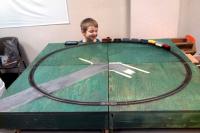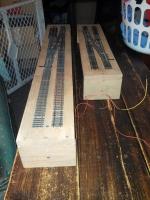Topics: Origins and Inspiration • Purpose • Namesake • Specifications
Phase 1 Modules • Phase 2 Modules • Russel's and Graham's Modules
Origins and Inspiration
Several events conspired to jump-start my desire to start building a small modular model railroad in 2013:
- I received several boxes of train stuff from a couple of friends. Included were numerous locomotives and rolling stock, most of which required more than a minimum amount of maintenance; and a significant amount of track, mostly sectional or "Snap Track".
- Putting together a circle of sectional track on the floor for testing model railroad equipment (such as the significant acquisition above) at home just wasn't a very good option.
- Bill Bedell (and several others) had a table-top modular demonstration layout at Trainfest that piqued my interest.
- The Waukesha County Gandy Dancers model railroad club had to reschedule a public-outreach appearance since no one had a large enough vehicle to carry our N scale layout.
- I had salvaged numerous 1x4's and 1x6's from a series of merchandising assignments.
Purpose
My purpose in building the Husher Central was to use as much of the stuff I had accumulated over the preceding few years, while creating a portable, expandable, simple layout. All of the wood used on the Phase 1 modules was recycled from other purposes – the plywood top was salvaged from the floor of my house, when I replaced a couple squeaky pieces of plywood with new sheets, and the 1x4 sides were originally crating for the aforementioned merchandising assignment. The track came mostly from the items given to me by my friends. I did buy some "N scale" cork roadbed, as I desired a lower profile than the standard "HO scale" cork.
Namesake
I grew up in a small community named "Husher" in the town of Caledonia in Racine County, on Highway 38 between Racine and Milwaukee. (The same road on which I lived also carries the name of Six Mile Road, as well as County Highway G.) The community – actually a "hamlet" according to some other students at my high school – was so named by a big fan of the state of Indiana (the Hoosier state) who didn't know how to actually spell Hoosier. The name stuck, but the pronunciation eventually changed to match the spelling. I allow either pronunciation for the Husher Central.
Specifications
- Modular design, able to be rearranged as needed and/or available.
- Uses as many recycled or repurposed components as possible.
- No legs! The modules are designed to sit on folding tables available at most model train shows, so they only have 2x4 feet that also serve as clamps to hold the modules together. (This is a direct copy of the design used by Bill Bedell's group.)
- Outside connectable framing must be standard 1x4 lumber, measuring 3½ by ¾ inches. Other framing may be miscellaneous dimensions.
- There are three standard options for the top surface:
- ½ inch plywood with "HO scale" roadbed. (Roadbed-track (e.g. Bachmann's E-Z Track) may also be used, provided that it is the same height as regular track on cork roadbed.)
- ⅝ inch plywood with "N scale" roadbed.
- ¾ inch plywood with NO roadbed. A standard "one-by" (e.g. 1x6) board may also be used.
- Track with Code 100 rail is preferred, as plenty of "train set" style track is readily available. Brass and steel track is allowed. Other rail sizes may be used, provided that connection is easily made with the common Code 100.
- Double mainlines are spaced 2" apart. There is no specification about position of the mainline(s) on the module, other than that mainlines must meet the end of the module at a 90° angle (i.e. is square to the end of the module).
- Connectable track must end 1½" from the end of the module, to allow common 3" connector track sections. Optionally, a 4½" gap may be left, for 6" connectors (to standard modules) or 9" connectors (to other 4½" gap modules).
- Variations from the specifications are allowed (and encouraged!) provided that connections to standard modules are available for both ends of the variation.
- Electrical connections and control:
- Each module should have a set of bus wires, connecting to a terminal block at each end, with at least one connection to the track. UPDATE 2/2/15: Although this was the original plan, I haven't been doing this.
- Current modules are set up for control using Atlas electrical switches and a two-cab DC system. UPDATE 2/2/15: This was never actually adopted. DCC will be the way to go, when the time comes to have full operations.
- Future plans include acquisition of a SPROG 3^, to be used with a Linux laptop and router for tablet/smartphone DCC operation. UPDATE 2/2/15: The SPROG 3 has been acquired, but needs to be fully tested using a working computer.
Phase 1 Modules
 |
|
| Phase 1 modules | |
The first four modules built for the Husher Central are all corner modules, 2 feet by 2 feet. The plywood is 5/8", recycled from a piece of floor that I replaced in my house, with "N Scale" roadbed. Track is comprised of one 18" radius "snap track", a half-section of 18" radius track, with 22" radius tracks at either end to provide a smoother transition to the straight bridge tracks and beyond. The Phase 1 modules had their own leg/foot system, before I developed (i.e. copied) the 2x4 feet/clamps. These modules also exhibit one of the flaws in my system, in that the outside corners are poorly supported.
Phase 2 Modules
 |
|
| Phase 2 modules | |
The first expansion of the Husher Central system came while I was looking at the 1x6's that I had gleaned from the crating from the merchandising project at Toys 'R' Us. While the 1x4's had an obvious use as framing for modules, the 1x6's didn't have quite as clear a fate – until I realized that, by using "N Scale" roadbed atop 5/8" plywood for the Phase 1 Modules, I had (quite by accident) matched the height (thickness) of a one-by board! Thus I realized that I could use the 1x6's with no roadbed to extend the length of the Husher Central.
Having only 5½" of width to work with meant that scenery would be minimal, so I decided that track would be the main star of these "mini-modules". About the only semblance of scenery was their dirt-colored paint job.
I decided to make two 3' long modules and two 2' long modules, and make them all double track with a crossover. I used some of the track that I had received from my friends, even modifying some curved track to make it straight! Unfortunately, I have only completed one 3-footer thus far, somewhat limiting the flexibility of the Husher Central.